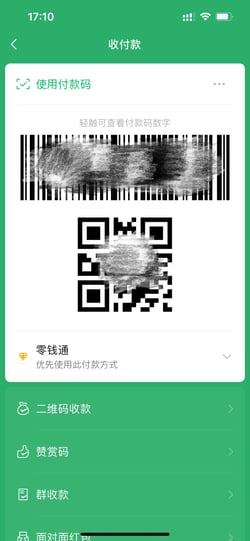The WeChat app truly paves the way to a streamlined digital life. This powerful platform goes far beyond messaging, allowing users to effortlessly conquer daily tasks like booking and paying for taxis, shopping online, or even scoring last-minute concert tickets for that night's show. The secret to this seamless experience? WeChat Pay, the integrated payment system that keeps everything smooth and centralized within the app.
WeChat Pay enables Chinese users to buy goods abroad in their preferred currency (CNY). Cross-currency settlements are also accepted, with the platform supporting 16 different currencies.
While WeChat Pay originated in China and is still deeply integrated into the Chinese financial system as the most widely used payment service in China, the app is no longer limited to the country. WeChat Pay is officially available to users in 69 countries and regions worldwide, including Germany and Switzerland.
The global acceptance of WeChat Pay is also impressive: more than 4 million foreign merchants are already connected to the platform and there are over 1,000 foreign co-operating institutions.

The number of active WeChat accounts has risen steadily since its market launch. At the end of March 2023, the Chinese multifunctional social media platform had over 1.3 billion monthly active users.
Many companies have already recognised the app's enormous potential and have tapped into the high-revenue Chinese market thanks to WeChat Pay. Whether for Chinese tourists or business people: more and more European companies are offering payment via WeChat Pay and are thus following the digital and global zeitgeist.
Discover WeChat Pay!
WeChat Pay, seamlessly integrated within the popular Chinese messaging app WeChat, is more than just a mobile wallet. It's a one-stop shop for payments. Users can make online and offline purchases, send/receive money, pay bills,and even top up phones – all within the app. Linking bank accounts or credit cards ensures secure funds storage.
But WeChat Pay goes beyond basic transactions. It facilitates food orders, taxi bookings, donations, and access to various services within the WeChat ecosystem. With over 1.3 billion users in 2023, it's China's dominant payment method, offering unmatched convenience through WeChat QR codes and other speedy transactions. WeChat integration allows seamless payments within numerous mini-programs and services.
While features differ slightly, Chinese users can link bank accounts for large-scale transfers, while international users typically use linked cards for payments at select overseas merchants (restrictions may apply).
WeChat in Germany and Switzerland
%20(1).webp?width=600&height=400&name=AdobeStock_329895540_Editorial_Use_Only%20(1)%20(1).webp)
In Germany and Switzerland, WeChat's functionality for non-Chinese users is still somewhat limited compared to the comprehensive offering in China. Although WeChat Pay is not yet widely accepted by merchants in these countries, there are encouraging signs of progress. For example, some merchants, especially those targeting Chinese tourists, have introduced WeChat Pay, making it easier for Chinese visitors to shop. In Switzerland, the acceptance of WeChat Pay is growing, bolstered by Worldline, a major payment processor that partnered with WeChat Pay in 2018 to enable Swiss merchants to accept payments from Chinese tourists.
For non-Chinese users in both countries, WeChat Pay primarily facilitates receiving money from Chinese contacts and making transactions at certain merchants that cater to Chinese customers, as other functions like topping up credit with local credit cards or linking local bank accounts are generally limited. However, for Swiss and German businesses, adopting WeChat Pay as a payment method offers significant opportunities. By integrating WeChat Pay, these businesses can tap into the vast Chinese market both offline and online. This allows German and Swiss merchants to cater to Chinese tourists more effectively and enables Chinese consumers to purchase goods from these countries even when they are overseas, thus expanding their market reach and enhancing sales potential.
How has WeChat Pay developed?
WeChat was launched in China in 2011 and quickly became the most frequently used messenger app in the Middle Kingdom. In 2013, the company Tencent introduced the payment function - a significant step that made the app a must-have for many users. It makes it possible to send and receive money securely and conveniently via the app. Together with AliPay, WeChat Pay now accounts for almost 90% of the mobile payment market in China. The smartphone has thus become a wallet in China. The WeChat Pay function has also been available in Europe since July 2017 and has since become increasingly popular in Western countries.
The ease of use, broad acceptance and integration into the WeChat ecosystem have contributed to WeChat Pay being widely used by both individuals and companies. Currently, WeChat Pay covers more than 300 banks and supports several foreign credit cards, including JCB, VISA and Mastercard. This means that Tencent users will have two mobile payment options.
How Does WeChat Pay Work?
WeChat Pay works via the WeChat app. Accordingly, you need a smartphone to install the app. An active WeChat account must then be set up and linked to the desired valid bank account in order to be able to use WeChat Pay. It is important that you have a bank account with a supported bank, as not all banks are compatible with WeChat Pay.
Furthermore, the payment function requires identity verification. This may involve entering personal information such as your name, telephone number and sometimes your identity card. However, the exact requirements and processes of WeChat Pay may vary by country and region. As soon as the WeChat account has been created and the bank details have been linked, you can access the menu and thus the various functions of WeChat Pay.
 |
 |
How are Commercial Transactions Operated in WeChat Pay?
Here are the different methods merchants can use to accept WeChat Pay for business transactions:
1. In-app payments: This is the most common method. Customers pay directly in the WeChat app via an integrated ‘WeChat Pay’ button in the shop's user interface.
2. External app integration: Merchants can integrate WeChat Pay into their own apps using the Software Development Kit (SDK). This allows customers to complete the payment within the merchant's app without having to switch to WeChat.
3. QR code payments: This method uses QR codes displayed on websites or in brick-and-mortar shops. Customers scan the code with their WeChat app to initiate the payment.
4. Quick Pay: With this method, customers can pay in brick-and-mortar shops by opening the WeChat Pay app, selecting Quick Pay and showing the cashier a QR code to scan.
 |
 |
The left-hand QR code is for paying in the shop (scan to pay), while the right-hand one is for receiving money (scan to transfer).
How Secure Is WeChat Pay?
WeChat Pay prioritises security for both users and merchants. This is ensured by a combination of technical measures and user authentication.For users:
- Secure account setup: Users lay a strong foundation by setting a secure password and enabling biometric authentication (fingerprint or facial recognition) when creating an account.
- Encrypted transactions: Advanced encryption technology protects sensitive data throughout the transaction process, preventing unauthorised access.
- Multi-factor authentication: Two-factor authentication provides an additional layer of security by requiring a one-time password (OTP) in addition to the password, which is sent to the user's registered mobile phone.
- Transaction monitoring: WeChat Pay continuously monitors transactions for suspicious activity and if irregularities are detected, users are notified of potential risks and additional security measures can be taken.
- Transparent transaction history: Users receive real-time notifications for each payment and can view their complete transaction history within the app. This allows unauthorised or suspicious activity to be quickly identified.
- User authentication: Since users confirm each transaction with a password or biometric verification, merchants can be sure that the payment was authorised by the rightful account holder.
- Real-time settlements: Funds are typically transferred to merchants' accounts quickly, minimising the risk of fraudulent transactions before funds are received.
- Regulatory compliance: WeChat Pay adheres to relevant security regulations,giving merchants peace of mind in terms of data protection standards.
What makes WeChat Pay stand out?
Compared to other mobile payment solutions, WeChat Pay is particularly impressive due to its simplicity, user-friendliness and integration into the WeChat app, which makes it a real all-rounder. The additional functions such as ordering taxis, tickets, goods and much more, combined with the option to pay for these directly, make this app so attractive for many users. Other useful functions include mobile credit top-ups and the digital sending of gifts of money in the form of red envelopes (traditional red envelopes for gifts of money, known as ‘hóngbāo’).
Ways in Which WeChat Revolutionizes E-Commerce and Retail Around The World
WeChat Pay has fundamentally changed the landscape of e-commerce and retail globally, especially in markets with high smartphone penetration. Here's how:
-
Frictionless payment increases conversion rates: The seamless payment experience in the app eliminates the need for complex registrations or redirects to external platforms (such as PayPal). This simplicity optimizes the checkout process, minimizes user abandonment and ultimately leads to higher conversion rates for companies.
-
Marketing with massive reach: The unique combination of messaging app, social media platform and digital wallet makes WeChat a powerful marketing hotspot. The huge user base gives businesses unparalleled reach. Companies can sell and advertise directly on the platform, promoting a seamless user experience. In addition, users can conveniently share purchases and make payments directly in chats with friends and family, influencing purchasing decisions and potentially triggering impulsive purchases.
-
Data-driven personalization: WeChat Pay collects valuable data on users' purchasing behavior. This data enables companies to provide targeted promotions, discounts, and personalized offers based on user preferences and activity in the app. This level of personalization improves customer retention and loyalty, further driving sales.
-
Build trust, increase sales: WeChat Pay has earned a reputation for high security, thereby promoting user trust in online transactions. This trust leads to more confidence and a greater willingness to make online purchases.
Overall, WeChat Pay's impact on e-commerce and retail is undeniable. By simplifying the checkout process, creating a powerful marketing platform, and enabling data-driven personalization, WeChat Pay has fundamentally changed the industry, creating a more convenient and secure shopping experience for businesses and consumers.
INTEGRATION OF OFFLINE SHOPS
Offline shops can be integrated into the app thanks to various features of WeChat Pay:
- QR codes : They are a central element for integrating offline shops into the WeChat app. Shops can create their own individual QR code, which is scanned by customers to process payments via WeChat Pay. The QR code can be placed, for example, at the checkout or on products.
- WeChat Account : If a store has an active WeChat account, customers can use the account to connect to the store to obtain information, view product information, place orders, and make payments via WeChat Pay.
- WeChat Mini Programs : These programs are standalone apps that work within the WeChat platform. A store can create a mini program that offers complete e-commerce functionality: from shopping to ordering and paying to tracking delivery - all in one app.
How is WeChat Pay different from other digital payment methods?
The most important advantage is the integration of WeChat Pay directly into the WeChat app. Shopping in the app or quickly completing other transactions is done securely and centrally. There is no need to log in again via an external platform, as is the case with PayPal, for example.
The WeChat Mini Programs are another feature that sets WeChat Pay apart from other mobile payment solutions. The mini programs, which are integrated directly into WeChat, can also be used to pay with WeChat Pay. This enables a complete shopping experience within WeChat - from product selection to payment.
WECHAT PAY FOR BUSINESSES – A REAL MUST-HAVE.webp?width=626&height=417&name=AdobeStock_379185484_Editorial_Use_Only%20(1).webp)
Companies that want to conquer the huge Chinese market cannot ignore WeChat Pay.
Benefits for businesses offering WeChat Pay as a payment method
Increase your customer base significantly by integrating WeChat Pay as a payment option. The simplicity of the transactions can increase your conversion rate enormously - after all, WeChat Pay accounts for almost 40% of the mobile payment market in China. This fact illustrates the great importance of this payment option for many Chinese people. With WeChat, companies gain a powerful opportunity to reach many consumers, conduct efficient WeChat marketing and increase their sales. You can interact with Chinese consumers in real time and bring your content to a wide audience. WeChat Pay is the icing on the cake: This payment function not only makes the purchase pleasantly easy for users, but also turns shopping into a homogeneous experience that is naturally integrated into everyday life. The smooth and efficient shopping process increases customer satisfaction.
Setting up WeChat Pay for businesses
The process of setting up WeChat Pay for businesses may vary slightly from country to country, but usually you will need to provide proof of business. This means you will need to prove the legal status of your business. This can be done, for example, through a copy of the commercial register or other official documents confirming the existence and legitimacy of the business.
Furthermore, proof of identity of the company owner or managing director is required. In addition, company documents such as the business license or tax number must be presented. Of course, a business bank account must also be available that can be used for payment processing with WeChat Pay. Appropriate proof of the bank account may have to be presented, such as bank statements.
Once all relevant documents have been fully submitted, you can enter into the WeChat Pay Merchant Agreement , which sets out the terms, fees and obligations for using WeChat Pay. This agreement may vary by country or region.
Once the company account has been set up, it's time for integration: whether in e-commerce platforms, point of sale (POS) systems (e.g. in stores), mobile apps, QR code payments or on websites - WeChat can be integrated into a variety of systems.
FUTURE DEVELOPMENTS AND IMPACT OF WECHAT PAY
For companies looking to enter the Chinese market, integrating WeChat Pay is no longer optional – it's necessary. WeChat Pay is seamlessly integrated into Chinese people's everyday lives and offers unmatched convenience for Chinese consumers both at home and abroad. Beyond pure transactions, the WeChat ecosystem allows you to create engaging customer journeys and leverage the platform's marketing tools to increase customer loyalty and revenue.
With the ongoing trend of globalization and app-centric features, WeChat Pay is poised to revolutionize payments worldwide. Its versatility offers a variety of options, from in-app web payments to QR code integration and compatibility with offline stores. All transactions are protected by strict security measures, ensuring peace of mind for businesses and users.
Are you ready to unlock the potential of WeChat Pay? We can help. Our W4 web-app development and China marketing team has the expertise to guide you through every step of the integration process and ensure a smooth and successful WeChat Pay implementation.












